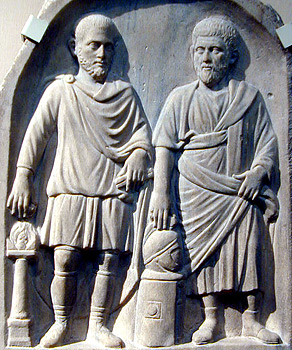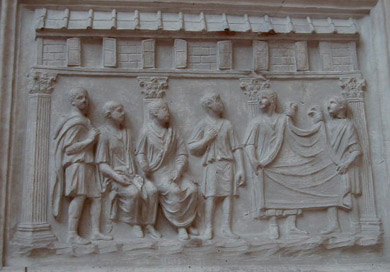
lacerna

The lacerna was one of several types of cloak, fastened on the right shoulder with a fibula, that the Romans adopted from neighboring peoples. It was worn over the tunic, as above, or over the toga, in bad weather, in damp cold climates, and on journeys outside of Rome. It was commonly used by Roman soldiers (e.g., Trajan's Column; Ovid, in Fasti 2.746, portrays Lucretia urging her maids to help her finish weaving a lacerna so that she can send it to her husband in the field). Since the lacerna was used as protection against the rain, it frequently had an attached hood (see cucullus).
In Satire 9, Juvenal's parasite Naevolus calls lacernae the "munimenta togae," and criticizes the ones he's received as gifts, calling them "greasy, coarse, and muddy in color, with threads lightly packed by the Gallic weaver" (Saturae 9.28-30). Originally it was a knee-length, dark (see tristium lacernarum and fuscos colores in Martial's Epigrammata 1.96.4-9), thick woolen mantle (see lacernae Baeticae in Martial, Epigrammata 14.133), but in imperial times the same word also applied to an elegant, lighter wrap which might be dyed Tyrian purple (Juvenal, Saturae 1. 27 and Martial, Epigrammata 8.10.1-2) or other colors (see Martial's lacernae coccineae in Epigrammata 14.131).
In Phillippics 2.76, Cicero reminds the Senate of the non-Roman attire -- a lacerna and Gallic shoes -- that Antony chose to flaunt when entering Rome from Gaul to stand for the consulship in 44 BCE . Nevertheless, this garment became so popular among the Romans that Suetonius tells us Augustus, exasperated by the sea of dark colors before his tribunal, forbade the wearing of the lacerna in the Forum and at the games, reaffirming the Romans to be "people of the toga" ( Vita divi Augusti 40). Despite his edict, the eminently practical lacerna remained in covert use in Rome under the Emperor Claudius (see Suetonius, Vita divi Claudi 6), and was commonly accepted in Martial and Juvenal's day (in Epigrammata 4.2 and Epigrammata 14.135 Martial testifies to the presence of white lacernae at public spectacles), and into the later Empire.
